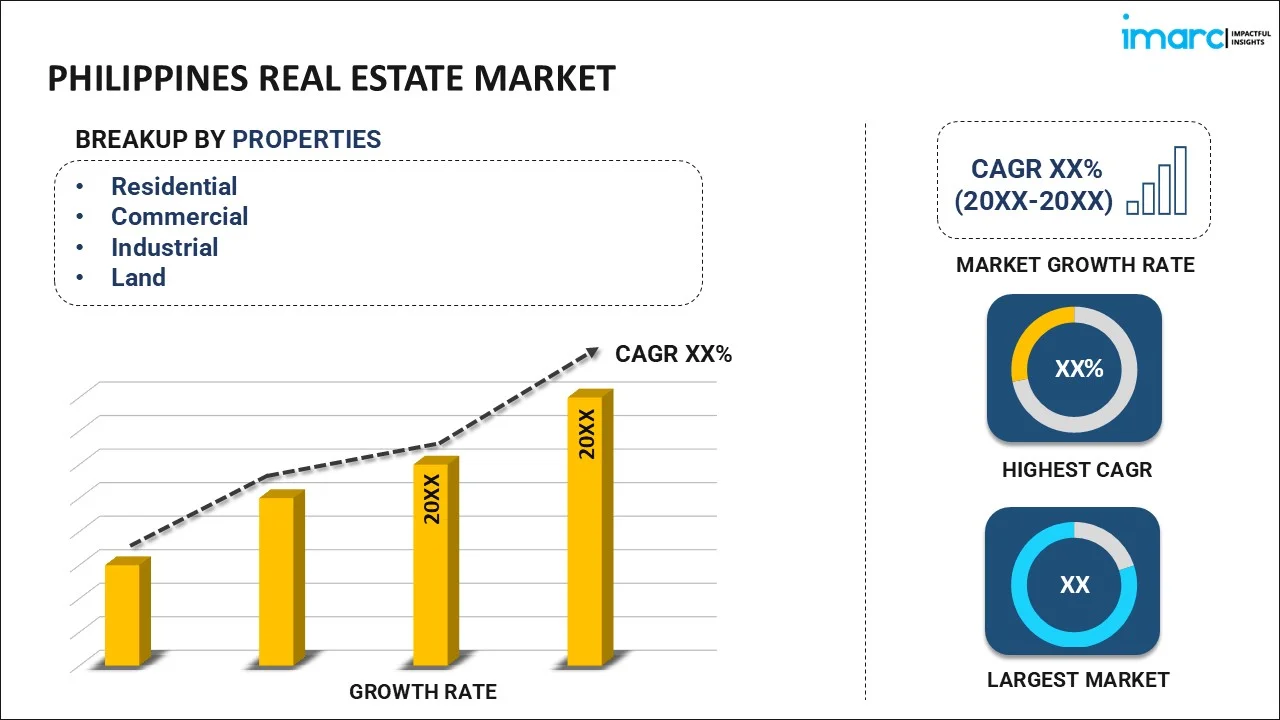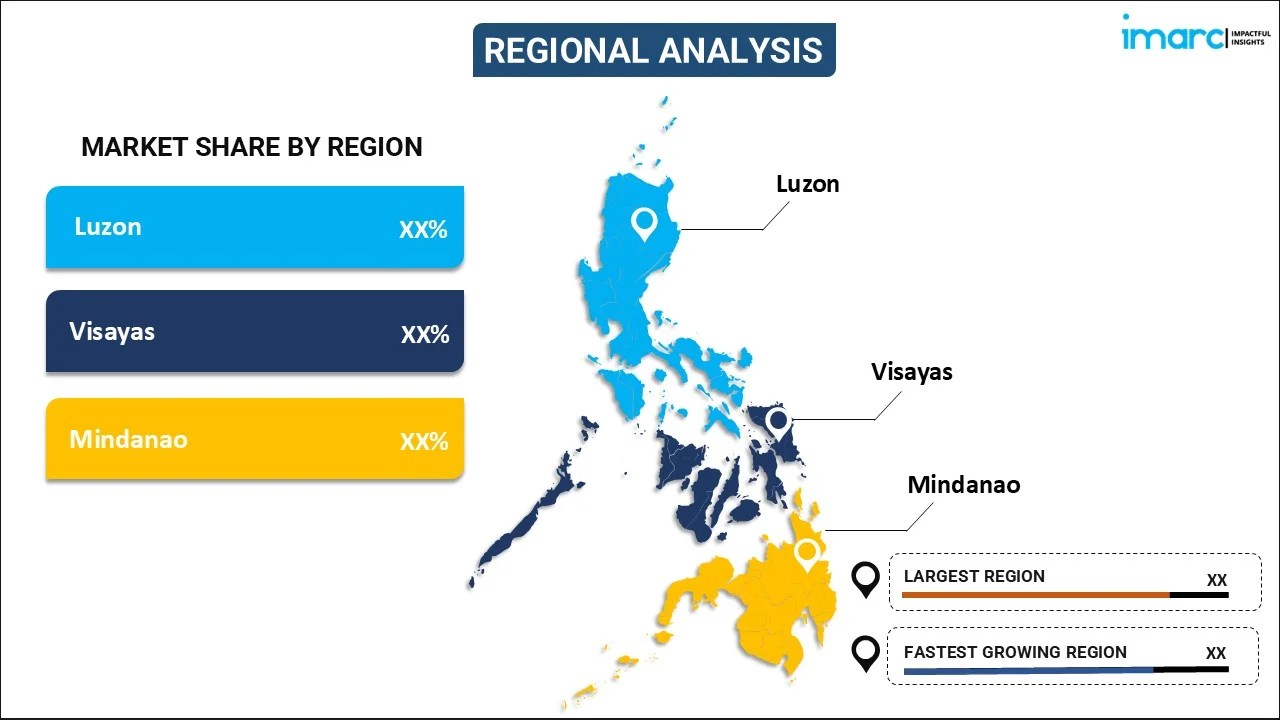
Philippines Real Estate Market Size, Share, Trends, and Forecast by Property, Business, Mode, and Region, 2025-2033
Philippines Real Estate Market Overview:
The Philippines real estate market size reached USD 90.51 Billion in 2024. Looking forward, IMARC Group expects the market to reach USD 131.41 Billion by 2033, exhibiting a growth rate (CAGR) of 4.34% during 2025-2033. The market is experiencing strong growth, driven by urbanization, infrastructure development, and rising foreign investments fueling the demand across various segments, including residential, commercial, and industrial properties.
|
Report Attribute
|
Key Statistics
|
|---|---|
|
Base Year
|
2024 |
|
Forecast Years
|
2025-2033
|
|
Historical Years
|
2019-2024
|
| Market Size in 2024 | USD 90.51 Billion |
| Market Forecast in 2033 | USD 131.41 Billion |
| Market Growth Rate (2025-2033) | 4.34% |
Philippines Real Estate Market Trends:
Urbanization and Expanding Middle Class
The real estate market in the Philippines is undergoing a significant transformation, driven by rapid urbanization and the expansion of the middle-class population. For instance, as per industry reports, in 2024, 56.43 Million individuals in Philippines, accounting for 48.7% of the total population, reside in urban areas. Cities like Metro Manila, Cebu, and Davao are observing accelerating demand for residential and commercial properties. The homeownership is leading growth of affordable and mid-range housing projects as these are being prioritized by the rising middle class. Developers are responding with innovative housing solutions that include vertical developments and gated communities, to cater the needs of urban residents. Simultaneously, the influx of professionals into urban areas is driving the demand for co-living spaces and rental properties. This trend is also motivating mixed-use developments, where residential units are merged with retail, office, and recreational spaces, which are reflecting the need for convenience in urban living. Urbanization is further hiked by government policies which promote sustainable development, attracting foreign investors into the Philippine real estate landscape.
Infrastructure Expansion and Connectivity
The aggressive infrastructure development of "Build, Build, Build" program is altering the real estate market by Philippine governments. The property demand in peripheral regions is making previously underdeveloped areas more accessible with investments made in transportation networks, including railways, highways, and airports. The connectivity between major cities and suburban areas, encouraging real estate developers to explore new opportunities are improved by these projects. Residential and commercial developments are clustering around transit-oriented locations which ensure convenience for commuters and businesses alike. Infrastructure improvements are elevating property values and attracting multinational corporations seeking prime office spaces in well-connected hubs. Additionally, the rise of Special Economic Zones (SEZs) around these projects is bolstering industrial real estate growth, providing a hike to logistics, warehousing, and manufacturing facilities. For instance, as per industry reports, in 2024, the U.S. and Philippines announced numerous bilateral economic ventures, encompassing Luzon Economic Corridor in March, which aims to boost infrastructure in Philippines.
Philippines Real Estate Market Segmentation:
IMARC Group provides an analysis of the key trends in each segment of the market, along with forecasts at the country level for 2025-2033. Our report has categorized the market based on property, business, and mode.
Property Insights:

- Residential
- Commercial
- Industrial
- Land
The report has provided a detailed breakup and analysis of the market based on the property. This includes residential, commercial, industrial, and land.
Business Insights:
- Sales
- Rental
A detailed breakup and analysis of the market based on the business have also been provided in the report. This includes sales and rental.
Mode Insights:
- Online
- Offline
A detailed breakup and analysis of the market based on the mode have also been provided in the report. This includes online and offline.
Regional Insights:

- Luzon
- Visayas
- Mindanao
The report has also provided a comprehensive analysis of all the major regional markets, which include Luzon, Visayas, and Mindanao.
Competitive Landscape:
The market research report has also provided a comprehensive analysis of the competitive landscape. Competitive analysis such as market structure, key player positioning, top winning strategies, competitive dashboard, and company evaluation quadrant has been covered in the report. Also, detailed profiles of all major companies have been provided.
Philippines Real Estate Market News:
- In November 2024, Eton Solutions announced the launch of a specialized Fund Accounting Platform for Private Equity, Real Estate, and Fund of Funds firms. Built on the cloud native AtlasFive® platform, the solution integrates AI to enhance fund management, compliance, and operational efficiency. With over USD 936 billion in assets managed, Eton aims to streamline global fund operations.
- In October 2024, Capital Corp Merchant Banking, announced substantial investment proposal for a mega township development venture in Philippines. This project highlights the firm's efforts to aid revolutionizing and sustainable real estate and infrastructure development globally.
Philippines Real Estate Market Report Coverage:
| Report Features | Details |
|---|---|
| Base Year of the Analysis | 2024 |
| Historical Period | 2019-2024 |
| Forecast Period | 2025-2033 |
| Units | Billion USD |
| Scope of the Report | Exploration of Historical Trends and Market Outlook, Industry Catalysts and Challenges, Segment-Wise Historical and Future Market Assessment:
|
| Properties Covered | Residential, Commercial, Industrial, Land |
| Businesses Covered | Sales, Retail |
| Modes Covered | Online, Offline |
| Regions Covered | Luzon, Visayas, Mindanao |
| Customization Scope | 10% Free Customization |
| Post-Sale Analyst Support | 10-12 Weeks |
| Delivery Format | PDF and Excel through Email (We can also provide the editable version of the report in PPT/Word format on special request) |
Key Questions Answered in This Report:
- How has the Philippines real estate market performed so far and how will it perform in the coming years?
- What is the breakup of the Philippines real estate market on the basis of property?
- What is the breakup of the Philippines real estate market on the basis of business?
- What is the breakup of the Philippines real estate market on the basis of mode?
- What is the breakup of the Philippines real estate market on the basis of region?
- What are the various stages in the value chain of the Philippines real estate market?
- What are the key driving factors and challenges in the Philippines real estate market?
- What is the structure of the Philippines real estate market and who are the key players?
- What is the degree of competition in the Philippines real estate market?
Key Benefits for Stakeholders:
- IMARC’s industry report offers a comprehensive quantitative analysis of various market segments, historical and current market trends, market forecasts, and dynamics of the Philippines real estate market from 2019-2033.
- The research report provides the latest information on the market drivers, challenges, and opportunities in the Philippines real estate market.
- Porter's five forces analysis assist stakeholders in assessing the impact of new entrants, competitive rivalry, supplier power, buyer power, and the threat of substitution. It helps stakeholders to analyze the level of competition within the Philippines real estate industry and its attractiveness.
- Competitive landscape allows stakeholders to understand their competitive environment and provides an insight into the current positions of key players in the market.
Need more help?
- Speak to our experienced analysts for insights on the current market scenarios.
- Include additional segments and countries to customize the report as per your requirement.
- Gain an unparalleled competitive advantage in your domain by understanding how to utilize the report and positively impacting your operations and revenue.
- For further assistance, please connect with our analysts.
 Inquire Before Buying
Inquire Before Buying
 Speak to an Analyst
Speak to an Analyst
 Request Brochure
Request Brochure
 Request Customization
Request Customization




.webp)




.webp)












